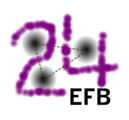Speaker
Description
In recent years, there has been a rapidly growing interest in ultracold hybrid atomic-ion systems. It is caused by the new opportunities opening here for modeling various quantum system and processes with controllable properties. Particularly, in the recent paper of Melezhik and Negretti[1] the confinement-induced resonances (CIRs) in ultracold hybrid atom-ion systems were predicted, which can be used for controlling the effective atom-ion interaction.
In my talk I will present recent results of my group on the few-body atom-ion systems. It is quantitative description of collisional dynamics near atom-ion CIRs with including the effect of the irremovable ion ``micromotion’’ in the Paul trap. Another problem was to extend the fundamental result by Olshanii[2] - the prediction of the s-wave CIRs in one-center confined problem - to the two-center confined problem[3]. While recovering the usual result when the scattering centers coincide [2,4], the conditions of CIR appearance for the general two-center case were derived. Our results can be potentially applicable in a number of hot problems in physics of cold atoms and ions: confined atomic scattering by fixed impurities, such as ions, Rydberg atoms or two-atomic molecules, with possible extension to N impurities.
References
[1] V.S. Melezhik and A. Negretti, Phys. Rev. A94, 022704 (2016).
[2] M. Olshanii, Phys. Rev. Lett. 81, 938 (1998).
[3] S. Shadmehri and V.S. Melezhik, Phys. Rev. A99, 032705 (2019).
[4] E.Haller, M.J. Mark, R. Hart, J.G. Danzl, L. Reichsӧlner, V.S. Melezhik, P. Schmelcher, and
H.C. Nӓgerl, Phys. Rev. Lett. 104, 153203 (2010).




